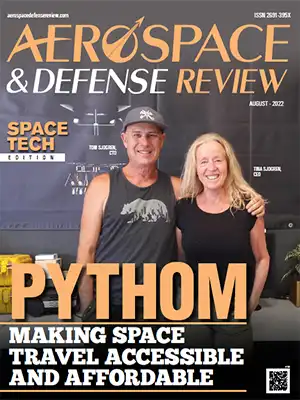THANK YOU FOR SUBSCRIBING
 Tina Sjogren, CEO Tom Sjogren, CTO
Tina Sjogren, CEO Tom Sjogren, CTO
“We manufacture space transportation systems, write control software, and test components in-house with our highly motivated workforce backed by strong leadership and an extended team of aerospace specialists,” says Tina Sjogren, co-founder and CEO of Pythom. Pythom uses computer-aided design, analysis, and manufacturing tools to achieve the most lightweight and efficient spacecraft possible. Further positioning Pythom as a competent space tech company is its past technological capabilities. Back when communication tools used in the extreme wilderness were bulky in size, firms required heavy equipment to haul them onto trucks before setting them up with a lengthy and cumbersome process. Pythom founders developed a software and hardware solution package that fit inside a Pelican case to eliminate the cumbersome transportation process of such bulky communication tools. Named Contact, it was featured on the front page of the Circuit in the New York Times for its success. This shows how technical and creative the Pythom team can be. Notably, the innovative communication device attracted customers ranging from climbers to the military, NGOs, and even NASA. The Pythom team is now transferring this methodology and design thinking to space tech. In doing so, Pythom ensures it abides by all guidelines and regulations set by the Federal Aviation Administration (FAA) and other local norms.
An Integrated Suite of Space Transport Solution Pythom is currently developing three distinct solutions:
the Eiger launch system, Pythom Spaceship, and Olympus Lander. Pythom’s light, low-cost, and highly responsive Eiger launch system is developed on in-house engine IP based on three main factors: selection of propellants, propulsion system, and design methods, all guided by simplicity and weight.
With such competencies, Pythom is now transferring the base technology of Eiger to an entire fleet encompassing rockets, spacecraft, and landers to offer a unified and integrated solution. “Pythom is mission-oriented, not technology-oriented. We are building an infrastructure transportation system that will make space access easy, highly responsive, and profitable, which is an innovation in itself for us,” states Tom Sjogren, co-founder and CTO of Pythom.
 Concurrently, the company’s Spaceship offering is based on Pythom’s proprietary mathematical modeling. The solution allows astronauts to manipulate artificial gravity in silos and create different space environments to acclimatize astronauts. Astronauts can even carry the Olympus Lander on the Pythom Spaceship. Once in orbit, Olympus Lander detaches from the spaceship and lands on a planet, a moon, or an asteroid. Olympus is designed to ferry humans and provisions, significantly simplifying the process of returning explorers to the spaceship. Both Olympus Lander and Pythom Spaceship use the same propellants and propulsion system as Eiger to launch from Earth, travel in space, and ascend/descend on other celestial bodies.
Concurrently, the company’s Spaceship offering is based on Pythom’s proprietary mathematical modeling. The solution allows astronauts to manipulate artificial gravity in silos and create different space environments to acclimatize astronauts. Astronauts can even carry the Olympus Lander on the Pythom Spaceship. Once in orbit, Olympus Lander detaches from the spaceship and lands on a planet, a moon, or an asteroid. Olympus is designed to ferry humans and provisions, significantly simplifying the process of returning explorers to the spaceship. Both Olympus Lander and Pythom Spaceship use the same propellants and propulsion system as Eiger to launch from Earth, travel in space, and ascend/descend on other celestial bodies.
-
We manufacture space transportation systems, write control software, and test components in-house with our highly motivated workforce backed by strong leadership and an extended team of aerospace specialists
Keeping Sustainability in Mind
Apart from its emphasis on the performance and functionalities of its integrated space transportation system, Pythom also has a laser focus on sustainability. In Tom’s and Tina’s words, even though the total amount of launch activities and their negative effect on the environment is small, most rockets release 15 kg to 35 kg of CO2 into the atmosphere for every kg of payload; and with increased space ventures in the next 5 to 10 years, the total CO2 emission from space missions can create a severe environmental impact for the planet. To steer away from such a future, Pythom has developed its proprietary Black Magic propulsion system that uses 100 percent renewable biomass fuel (waste products of corncobs). The produced carbon dioxide can then be absorbed by a new batch of corn, essentially dialing down the net carbon emission to zero.
Besides, the biofuel also ensures zero nitrogen oxide and harmful alumina particle production.
The Next Step: Taking Humans to Space
As the founders of Pythom highlight, what drives the company is the possibility for civilians to travel to space and other planets. “Our dream, vision, and master goal have always been the realization of human interplanetary space travel. Not in big spaceships but early exploration style, light, and fast vessels,” adds Tom. “As an example, one can look at how Norwegian explorer Roald Amundsen conquered the famous Northwest Passage (the sea route between the Atlantic and Pacific oceans through the Arctic Ocean) on a fishing boat even when naval ships failed to accomplish the same task. That’s the approach we believe in.” Pythom will continue doubling down on this vision in the coming months.
At present, Pythom is changing from prototyping to flight-ready manufacturing. “What we build now will fly to space within a year,” states Tina. On this note, Pythom expects its flight-ready propellant tanks, propulsion systems, avionics, and attitude control systems to be ready by Q3 2022. The first launch will go to the edge of space (Karman line) within 12 months, and the launch to orbit will follow soon. With these visions, Pythom is all set to play a catalytic role in space flight and help human society take a giant leap forward as spacefaring species.






